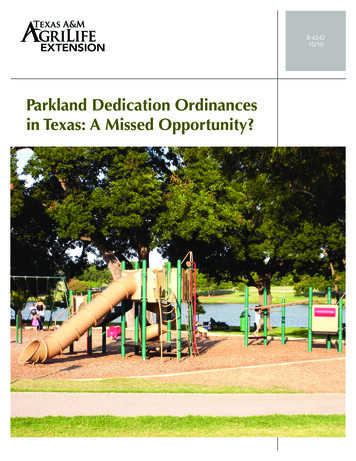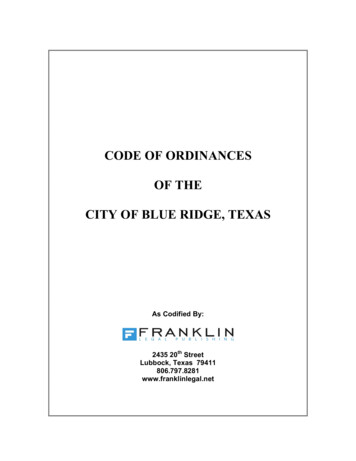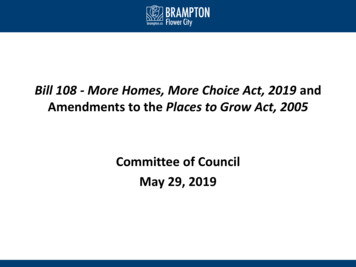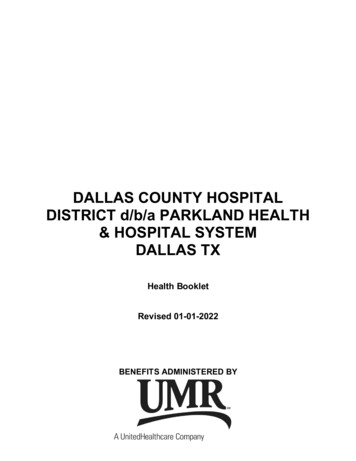
Transcription
B-624210/10Parkland Dedication Ordinancesin Texas: A Missed Opportunity?
Parkland DedicationOrdinances in Texas:A Missed Opportunity?John L. CromptonDistinguished Professor and Regents ProfessorDepartment of Recreation, Park and Tourism SciencesTexas A&M UniversityForeword byJamie Rae WalkerTexas AgriLife Extension SpecialistThis study was supported in part by a grant from theTerese and Jacob Hershey Foundation
1. Executive summary. 72. Evolution of parkland dedication ordinances in Texas. 113. Assessing the constitutionality of parkland dedication ordinancesin Texas: a framework of four criteria. 19Calculation of the amount of a park dedication requirement.19Overview of parkland dedication requirements in Texas cities.23Calculation of the parkland dedication requirement.24Calculation of the fee-in-lieu.26Calculation of park development fees.28The leverage potential of dedication ordinances.30Credit for private park and recreation amenities.32Reimbursement clause.34Timing of the dedication requirement.35Adherence to the nexus principle.35Time limitation for expending fees-in-lieu.36The scope and range of Texas cities’ parkland dedication ordinances.38Types of parks specified in the ordinances.38Nonresidential parkland dedications.40Extending ordinances to extraterritorial jurisdictions.414. Time frame for revising ordinances. 435. Criteria for acceptance of parkland. 45Minimum size.45Acceptability of floodplain and detention pond land.456. Concluding comments. 49The unrealized potential of parkland dedication ordinances.49Restricted scope.49Below-cost dedications.50Why is the potential not being realized?.52Inertia.52Opposition from the development community.52The economic case for parkland dedication ordinances.54The emerging O&M argument.56The political case for parkland dedication.577. References. 61Contents
1—5ExecutivesummaryForewordThe population of Texas continues to grow rapidly, and citiesare confronted with the challenge of providing facilities to servicethis growth. Over the past 25 years, about 50 Texas cities haveenacted parkland dedication ordinances to address park needsrelated to such growth.In this publication, John L. Crompton, Distinguished Professorand Regents Professor at Texas A&M University, reviews parklanddedication ordinances that have been enacted in 48 Texas cities.The analysis identifies what constitutes best practices whenestablishing or revising a parkland dedication ordinance. We hopethis information will enlighten Texas community leaders on thepossibilities this approach offers for ensuring that future residentshave access to parkland and the associated benefits.—Jamie Rae WalkerAssistant Professor andTexas AgriLife Extension SpecialistThe Texas A&M University System
Executive summary The study analyzed the parkland dedication ordinances of 48 Texas citiesand reported the acres of parkland per 1,000 population in 83 Texas cities. The Texas Supreme Court in 1984 ruled parkland dedication to beconstitutionally legal. The magnitude of a parkland dedication is guided by the U.S. SupremeCourt ruling in 1984 that the dedication requirements imposed on adeveloper should be “roughly proportional” to the increased demands ofthe proposed development on a city’s park system.Conclusions The unrealized potential for additional funding from the parklanddedication ordinances of 44 of the 48 cities is estimated to range from 300percent to 3,600 percent. This foregone revenue stream stems from twosources: Many ordinances are restricted to only a subset of parks—typicallyneighborhood, or neighborhood and community parks—instead ofall parks, and they do not extend into the extraterritorial jurisdiction(ETJ) areas. The dedications are fixed at levels far below the cost of acquiring anddeveloping parks. The dedications fail to follow the U.S. SupremeCourt’s guidance that they should be “roughly proportional” to theincreased demands new homeowners put on a park system. In 38 ofthe 48 cities, the ordinances were confined to parkland acquisitionand failed to include a fee for park development. A large majority ofcities failed to use empirical procedures to identify accurate levels ofservice and costs. Instead they used arbitrary numbers—even thoughthis approach is illegal. Without these empirical data, elected officialsremain unaware of the large opportunity costs incurred. The potential of parkland dedication ordinances remains largelyunrealized because many elected officials are unaware of their existenceor importance, and/or because elected officials are reluctant to confrontthe vigorous opposition to increases in dedications that invariably arisesfrom the development community, which is a powerful constituency inmany communities. Elected officials should support substantial enhanced dedications forthree powerful political reasons: It is a fiscally conservative action. A bedrock principle of fiscalconservatism is that those who benefit from government servicesshould pay for them. Elected officials can respond to the amenity needs created by newgrowth by requesting existing residents to pay for them, by notproviding them, or by requiring the new development to payfor them. Few elected officials in Texas are likely to run for officeon a platform of raising taxes on existing residents or lowering acommunity’s quality of life, which are the first two options.1—7Executivesummary
1—8Executivesummary Increases in dedications are unlikely to lead to any increases in theprice of new homes. Rather, these increases are likely to be absorbedby reducing the house size by a minimal amount, reducing the costsof finishes and fittings in the house, or paying less for the land.Findings from the analysis The dedication requirement in a parkland dedication ordinance shouldcomprise three elements: a land requirement; a fee-in-lieu alternativeto the land requirement; and a parks development fee. The first twocomponents were incorporated in all 48 ordinances reviewed, but only10 of the ordinances contained provision for a park development fee.Ordinances that contain only the land and the fee-in-lieu elementsrequire existing taxpayers to pay the costs of improvements to transformthe bare land into a park. The most widely accepted approach to meeting the U.S. Supreme Court’s“rough proportionality” criterion is to assume that new residents’demands will require the same level of service as those of existingresidents in the community. A recommended approach for calculatingthat level of service is provided. The amount of cash for a fee-in-lieu should be equal to the fair marketvalue of the land that would have been dedicated. However, the methodsof establishing the equivalence of fair market value vary widely, andsome of the approaches could be challengeable in the courts. Some of the 10 cities that charge a park development fee appear to deriveit arbitrarily rather than empirically, which is unlikely to be accepted bythe courts. It is advantageous for small cities that anticipate future growth to investsubstantially in park areas in their early stages of development, becausethat investment could be used to leverage relatively large dedicationsfrom developments as the city grows. To measure the “roughly proportional” impact of a development onthe public park system, the mitigation contribution of private amenitieswithin the development must be accommodated. However, 27 of the 48ordinances do not include a provision authorizing any credits for privateamenities; others insert an arbitrary limit of 50 percent or 100 percent;and others leave it to the city’s discretion. All of these options fail toprovide an empirical quantitative approach to providing “proportionate”credit for private amenities. Most ordinances include a reimbursement clause authorizing cities toacquire and develop parks in advance of need when land is more readilyavailable and less expensive, and to use dedication fees to reimbursethemselves later.
1—9Executivesummary Almost all cities require a fee-in-lieu and/or park development fee to bepaid before filing the final plat. There is widespread adherence to the nexus principle in the 48ordinances. This is done by creating zones and ensuring that the moneygenerated from developments in a zone is expended in that zone. Thecommunities without zones tend to be relatively small cities in which allresidents could be deemed as being near a park wherever it is located. Although court rulings direct that fees-in-lieu should be expended ina reasonable time frame, 16 of the 48 cities fail to specify a time frameof any kind. Most of the remaining 32 cities interpret “reasonable timeframe” as either 10 or 5 years. In 17 of the 48 ordinances, the parkland dedication authority is confinedto neighborhood parks. The remaining two-thirds provide enablingauthority for a broader set of parks beyond the neighborhood level. Three cities extend their ordinances to include nonresidential as wellas residential property. It is doubtful that nonresidential dedicationrequirements can meet the courts’ “roughly proportionate” criterion. Cities in Texas have legislative authority to regulate subdivisions intheir ETJs. However, only seven of the 48 ordinances provide enablingauthority to require parkland dedications from developments in the ETJ. Some of the ordinances’ inadequacies can be attributed to the lack ofa requirement for them to be reviewed periodically. Only 11 of the 48ordinances have a time frame for regularly reviewing the ordinanceincorporated into it. Most ordinances specify a preferred minimum size for dedicatedparkland. The most common preferred minimum size was 5 acres. A large majority of ordinances declare that floodplain land is undesirableand unlikely to be accepted as part of a dedication requirement, exceptin unusual cases. When it is accepted, most cities limit it to 50 percentof a dedication, and 11 cities require it to be discounted, equating 2 or 3floodplain acres of floodplain to 1 acre of parkland. Only a few ordinances speak to the issue of detention/retention areasbeing accepted to meet dedication requirements.
Evolution of Parkland DedicationOrdinances in TexasTo determine the status of parkland dedication ordinances in Texas, a survey wassent to all municipalities in Texas that were known to have public park amenities.Of the 117 cities contacted, 83 responded and 48 of those reported that they hadparkland dedication ordinances. Copies of those ordinances can be viewed atwww.rpts.tamu.edu/landdedication. The content of those 48 ordinances serves asthe basis for this report.The 83 cities that responded are listed in Table 1. Although some of these cities didnot have parkland dedication ordinances, all did report their total parkland acreages.Most of the population data were provided by the cities’ park and recreationdirectors who responded to the survey. In the few instances where these data werenot given, Census Bureau estimates of population were used. Table 1 shows thestandard of park provision in acres per 1,000 population for these 83 cities.Table 1. Acres of parkland per 1,000 population in 83 Texas cities.CityThe ColonyMadsonvillePopulation36,000Total 7656,56216,862.0025.6814,500354.0024.41AlvinGrand PrairieAustinHighland VillageWichita wnwoodLufkin36,800700.0019.02Cedar 32,000592.0018.50Dallas1,200,00021,500.0017.92Deer Park30,000527.0017.57League 4622,880.0015.78Mont BelvieuCarrollton116,5001,793.0015.39Cedar Continued on next page2— 1111Evolution ofordinances
2— 12Evolution ofordinancesContinued from previous pageCityFriscoMcKinneyCollege StationTotal 500400.0013.56Baytown70,513950.0013.47Missouri ington362,4264,651.6012.83San 10.28DentonParklanddedication isa requirementimposed bya localgovernmentalentity mandatingthat subdivisiondevelopers orbuilders dedicateland for a parkand/or pay a feeto be used bythe governmententity to acquireand developpark facilities.PopulationHuttoRed 9.009.94Greenville25,000242.009.68Flower xahachie25,000230.009.20HoustonNew y City18,000150.008.33
2— 1313Evolution ofordinancesContinued from previous pageCityPopulationTotal parkacreageAcres/1,000residentsSan 237.006.43Pasadena150,000919.746.13La 221,586.465.41HaltomCorpus .6116,00013.500.84Richland HillsWest UniversityPlaceParkland dedication is a requirement imposed by a local governmental entitymandating that subdivision developers or builders dedicate land for a park and/or pay a fee to be used by the government entity to acquire and develop parkfacilities. These dedications help provide park facilities in newly developed areas ofa jurisdiction without burdening existing city residents. They may be considered atype of user fee because the intent is that the cost of new parks should be paid for bythe landowner, developer, or new homeowners who are responsible for creating thedemand for the new park facilities.The philosophy is that new development generates a need for additional parkamenities, and the people responsible for creating that need should bear the cost ofproviding the new amenities. Neighborhood and community parks are intended toserve those people in the areas near them. Thus, they make no positive contributionto the quality of life of existing residents, suggesting that existing residents shouldnot be asked to raise their taxes to pay for them. In essence, what a community issaying to new residents is: “This is the quality of life we have here. If you move here,we expect you to maintain it. If you are not willing to pay this parkland dedicationfee, then go elsewhere where the fee is lower because that city has an inferior parksystem.”An appealingfeature ofparklanddedication isthat it respondsto marketconditions.
2— 14Evolution ofordinancesParkland dedication in the United Stateshas a 90-year history. The first ordinancewas passed by the state of Montanain 1919. It stated, “For the purpose ofpromoting the public comfort, welfareand safety, such plat and survey mustshow that at least one-ninth of the plattedarea, exclusive of streets, etc., is foreverdedicated to the public for parks andplaygrounds.” In 1923, the City of Bluefield,West Virginia, required “not less thanfive percent of the area of all plats shallbe dedicated by the owner for parks andplayground purposes except in the case ofa very small area.”2The earliest parkland dedicationordinances in Texas were enacted byCorpus Christi in 1955, Deer Park in 1959,and Carrollton in 1962. Wichita Fallsenacted an ordinance in the 1950s butrescinded it in the 1970s.Two earlier studies have reported on thestatus of parkland dedication ordinancesin Texas. In 1977, a survey of 107 Texascities received responses from 59 cities;3of those, 12 reported having a parklanddedication ordinance. However, two of the12 municipalities reported that they did notenforce their ordinances because of thequestionable legality of such ordinances atthat time.Ten years later in 1987, 183 Texascommunities were contacted. Of these,113 responded (62 percent) and 19 ofthem reported having parkland dedicationordinances.4An appealing feature of parkland dedication is that itresponds to market conditions. If fewer new people cometo the city than predicted, less money is forthcoming andfewer parks are built. Similarly, as costs for acquisitionand development of parks increase or decrease, theparkland dedication requirements can be increased ordecreased accordingly.Perspectives toward parkland dedication are likelyto vary among different stakeholders, such as electedofficials, developers, new residents, and existingresidents1. However, parkland dedication enableselected officials, who are the key decision makers on thisissue, to protect the interests of current residents and tomanage growth.A basic and long-held principle of growthmanagement is that development must be supportedby adequate public facilities and services and thatprivate and public investment must be coordinated toachieve that objective. Parkland dedication ordinancesare intended to ensure that park facilities are availablewhen homeowners buy their new homes, and to avoidauthorizing development without ensuring that the parkinfrastructure necessary to support the new demands isavailable.In the early days of parkland dedication ordinances,there was some doubt about their legality in Texas. Somepeople claimed that they were unconstitutional becausesuch ordinances violated the Fifth Amendment to theU.S. Constitution, the last 12 words of which are “norshall private property be taken for public use, withoutjust compensation.” However, in 1984 the Texas SupremeCourt concluded in City of College Station v. Turtle RockCorporation5 that requiring parkland dedication or feesin-lieu “was a valid exercise of the city’s police powerbecause it was substantially related to the health, safety,and general welfare of the people.”Before the Turtle Rock case, fewer than 10 cities in Texashad active ordinances. Table 2 shows that once the doubtsrelating to the constitutionality of such ordinances wereremoved in 1984, the number of cities adopting themincreased markedly.
2— 1515Evolution ofordinancesTable 2. Years when Texas cities first enacted parkland dedication ordinances.1Time period# of cities 89151990–199451995–199972000–20044Wichita Falls enacted an ordinance in the 1950s, but rescinded it in the 1970s.Angleton enacted an ordinance, but the city’s parks and recreation director reported that“it has never been enforced.”1There is sometimes confusion between parkland dedication fees and impactfees. Parkland dedications emanate from the “police powers” of Texas home rulemunicipalities; these powers enable cities to take actions that promote the health,safety, and welfare of their residents. In contrast, impact fees require enablingauthority from the state legislature before they can be imposed.Of the 27 states that have passed impact fee enabling legislation, 22 authorizeimpact fees for park and recreation amenities. Only in Texas, Illinois, New Jersey,Pennsylvania, and Virginia does the impact fee authorization not embrace parks.6In the other 22 states, it is possible for cities to impose both parkland dedication feesand impact fees. The latter can be used to fund a much wider array of recreationalopportunities than basic park amenities.However, Texas has not granted enabling authority for impact fees. In 1986 whenthe Texas legislature authorized impact fees, it confined them to only “water supply,treatment and distribution facilities; wastewater collection and treatment facilities;storm water, drainage, and flood control facilities, and roadway facilities.” With theTurtle Rock case fresh in their minds, the conservative Texas legislature specificallystated, “The term [impact fee] does not include dedication of land for public parks orpayment in lieu of the dedication to serve park needs.”The earliest parkland dedication ordinances in Texas were confined to land.They required the developer to deed a specified amount of acreage based on thenumber of residents expected to live in the area. These ordinances had three inherentweaknesses: Because most developments are small, only small, fragmented spaceswould be provided. The land dedicated by the developer was likely to be the least suitable forbuilding on (often drainage ditches, flood plain, or detention ponds), andit may also have been unsuitable for park use. The location of the parkland was determined by the location of thedevelopment.Fees-in-lieu givethe city theoption ofdeclining adedication ofland and insteadrequire thedeveloper to paya sum based onthe fair marketvalue of the landthat otherwisewould have beendedicated. Feesin-lieu can alleviateweaknessessometimesassociatedwith parklanddedicationordinances.
2— 16Evolution ofordinancesThese limitations quickly encouraged cities to broaden their ordinances to requiredevelopers to contribute cash instead of dedicating land. These cash payments weretermed fees-in-lieu. They gave the city the option of declining a dedication of land andinstead requiring the developer to pay a sum based on the fair market value of theland that otherwise would have been dedicated.The Turtle Rock case established the constitutionality of parkland dedication inTexas, but it required that “regulation must be reasonable.” It defined reasonableas “a reasonable connection between the increased population arising fromthe subdivision development and increased park and recreation needs in theneighborhood.” Because this definition was rather nebulous, the focus of mostlegal challenges after Turtle Rock shifted from whether parkland dedication wasconstitutionally legal, to what constituted a reasonable dedication requirement.A definitive guideline for answering this question was provided a decade laterin Dolan v. City of Tigard7 in which the U.S. Supreme Court ruled that there must bea “rough proportionality” between the conditions imposed on a developer and thedemand from the projected development. The court stated, “no precise mathematicalcalculation is required but the city must make some sort of individualizeddetermination that the required dedication is related both in nature and extentto the impact of the proposed development.” The court went on to note that inmaking the individualized determination, “the city must make some effort toquantify its findings in support of the dedication.” Thus, to survive a constitutionalchallenge, Dolan requires a city to demonstrate a “roughly proportional” quantitativerelationship between dedication requirements imposed on a developer and theincreased demands of the proposed development on its parks system.In the Turtle Rock case, the Texas Supreme Court stated that the “burden rests onthe real estate developer to demonstrate that there is no such reasonable connection”in any challenge to an ordinance. Thus, before the Dolan case, Texas developerschallenging a city’s dedication ordinance had to prove it was unfair. The Dolandecision shifted the burden of proof to cities—they must now justify that anordinance is fair. It requires cities to make individualized determinations thatevery parkland dedication effects a roughly proportional response to the demandgenerated by a development. This is a radical change that most Texas cities have notembraced in their ordinances. Failure to consider it leaves them vulnerable to theirordinances being challenged successfully and ruled illegal.The requirements of the Supreme Court’s ruling are manifested in theintroduction to the City of Mansfield’s ordinance, which states:The City of Mansfield has adopted by Council action the MansfieldParks, Open Spaces and Trails Master Plan, which providesplanning policy and guidance for the development of a municipalpark and recreation system for the City of Mansfield. The planhas assessed the need for park land and park improvements toserve the citizens of Mansfield. The plan has carefully assessedthe impact on the park and recreation system created by eachnew development and has established a dedication and/or costrequirement based upon individual dwelling units. The planconstitutes an individualized fact based determination of the
2— 1717Evolution ofordinancesimpact of new living units on the park and recreation system andestablishes an exaction system designed to ensure that new livingunits bear their proportional share of the cost of providing parkand recreation related services. Park land dedication requirementsand park development fee assessments are based upon themathematical formulas and allocations set forth within the plan.Texas’ interpretation of the Dolan case has been codified in the Texas statutes(212-904) which mandate that “the developer’s portion of the costs may not exceed theamount required for infrastructure improvements that are roughly proportionate tothe proposed development.”
Assessing the constitutionality ofparkland dedication ordinances inTexas: a framework of four criteria3— 19ConstitutionalityThe guidance provided by the Turtle Rock, Dolan, and some subsequent caseswhere courts have provided some minor clarifications of issues in those two majorcases, suggests that four broad criteria may be used to assess the constitutionality ofparkland dedication ordinances in Texas. These four criteria provide the frameworkfor most of this report: The method of calculating a parkland dedication requirement mustdemonstrate that it is proportionate to the need created by a new development. The ordinance must adhere to the nexus principle. A time limit must be set for expending fees-in-lieu. The scope and range of the ordinance must be delineated.Calculation of the amount of a park dedication requirementThe dedication requirement in a parkland dedication ordinance should comprisethree elements: A land requirement A fee-in-lieu alternative to the land requirement A parks development feeAlthough the first two elements were incorporated in all 48 Texas ordinancesreviewed in this study, the park development fee is a more recent addition to theordinances and has been incorporated in only 10 of them.A problem with ordinances that contain only the land and fee-in-lieu elementsis that they provide only for the acquisition of land. The additional capital neededto transform that bare land into a park is borne by the existing taxpayers. In someinstances, the result is that the dedicated land is never developed into a park andremains sterile open space that detracts from the community’s appeal rather thanadding to it. This led 10 Texas communities to expand their ordinances to incorporatea park development fee element to cover the cost of transforming the land into apark. Thus, the scope of parkland dedication ordinances in Texas has broadened asthey have gained legal and public acceptance.The most widely accepted approach to meeting the Dolan “rough proportionality”criterion is to assume that the new residents’ demands will require the same levelof service as those of the existing residents in the community. The courts haveruled consistently that stand
establishing or revising a parkland dedication ordinance. We hope this information will enlighten Texas community leaders on the possibilities this approach offers for ensuring that future residents have access to parkland and the associated benefits. Jamie Rae Walker—










